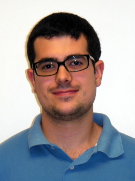
A general framework for the three-dimensional simulation of fluid surfaces
16 May, 2018 @ 12:00 pm - 1:00 pm
 Alejandro Torres-Sánchez (Logroño, Spain) received a B.S degree in Physics from Universidad de Zaragoza, a B.S. degree in Mathematics from Universidad Nacional de Educación a Distancia, a M.S degree in theoretical physics from Université de Cergy-Pontoise, and a Ph. D. in Applied Mathematics from UPC. His research focuses on the development of theoretical and computational approaches to study the mechanics of biological systems, such as lipid bilayers or the cell cortex.
Alejandro Torres-Sánchez (Logroño, Spain) received a B.S degree in Physics from Universidad de Zaragoza, a B.S. degree in Mathematics from Universidad Nacional de Educación a Distancia, a M.S degree in theoretical physics from Université de Cergy-Pontoise, and a Ph. D. in Applied Mathematics from UPC. His research focuses on the development of theoretical and computational approaches to study the mechanics of biological systems, such as lipid bilayers or the cell cortex.
Fluid surfaces are thin structures that display an exceptional mechanical duality: they deform in space as solid shells, but at the same time they present an in-plane fluidity, which results in flows of material tangent to the surface. Fluid surfaces are a common motif in cell and tissue biology, with examples including lipid bilayers, the acto-myosin cortex, or epithelial monolayers. The mechanical duality of these surfaces plays an essential role in biological processes from subcelullar to tissue scale, including endocytosis, cytokinesis, or morphogenesis. Thus, there is an increasing interest in modeling and simulating fluid surfaces. However, simulating fluid surfaces involves several numerical challenges. On the one hand, the fluid nature of these surfaces defies classical Lagrangian or Eulerian descriptions of deforming bodies. Indeed, the in-plane fluidity of the interface can lead to large distortions in a Lagrangian framework. On the other hand, since one needs to track the position of the interface in Euclidean space, the meaning of an Eulerian description is unclear. Arbitrarily Lagrangian-Eulerian (ALE) formulations, well established for bulk media appear as a natural choice, but such a formulation for a deforming surface needs careful consideration. Here, we introduce a generalization of ALE methods to fluid surfaces based on surface parametrizations. On the other hand, the governing equations usually involve higher-order derivatives of the parametrization, which cannot be handled with classical finite elements. Here, we discretize our equations based on subdivision finite elements, which lead to C1-continuous parametrizations. Furthermore, the governing equations result in a mixed system of elliptic and hyperbolic partial differential equations, which are stiff and difficult to integrate in time. For the time-integration of the equations, we develop a variational time integrator, rooted in Onsager’s variational principle, that endows the dynamics with stability by construction. Finally, to simulate the mechanics of fluid surfaces usually one needs to discretize vector or higher-order tensors on the surface. We develop two alternative methods for the discretization of vector fields, based on the Hodge decomposition of forms and on local Monge parametrizations respectively, and show the generalization of the second to higher-order tensors. We show the application of our theoretical and computational methodology in examples involving lipid bilayers and the cell cortex.
